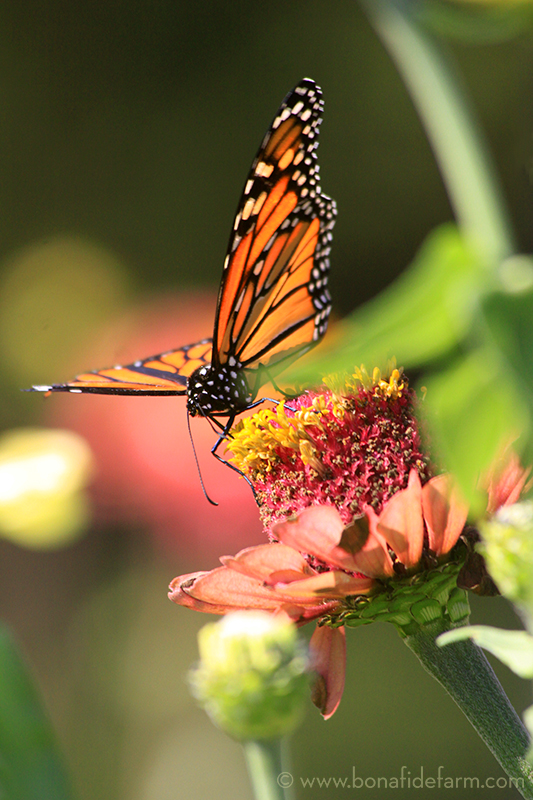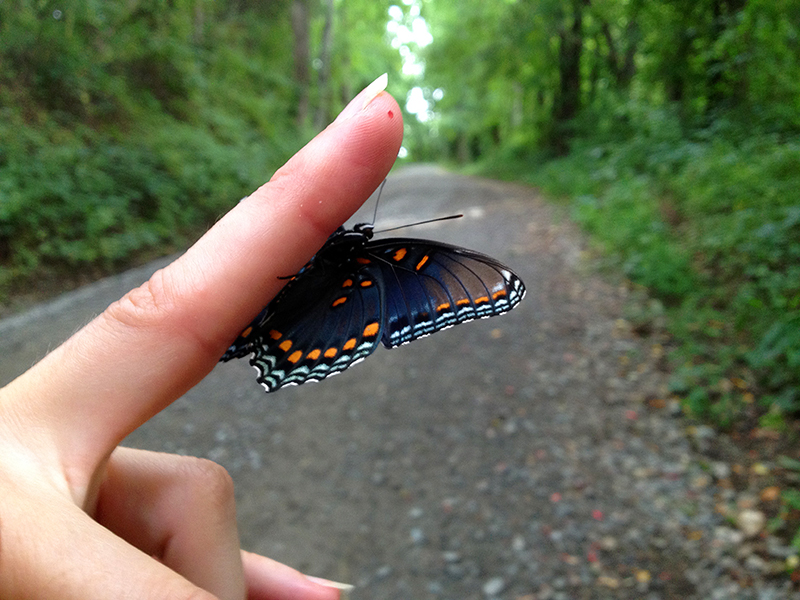I found this lone monarch feasting amongst the zinnas last week. Given all the trouble monarchs are in, I was very happy to see it and to know I’d done my part to cultivate a delicious banquet of nectar-rich flowers. I wonder if this butterfly was refueling on its migration to Mexico?

Monarch butterflies are decreasing at an alarming rate: 59% in the last year according to a survey carried out during the 2012-2013 winter season by the WWF-Telcel Alliance, and Mexico’s National Commission of Protected Areas (CONAP). The numbers of monarchs are at their lowest numbers in 20 years. According to the same organization:
The latest decrease in monarch butterflies is likely due to a decrease in the milkweed plant (Asclepias) – a primary food for monarchs – from herbicide use in the butterfly’s reproductive and feeding grounds in the US, as well as extreme climate variations during the fall and summer affecting butterfly reproduction.
Why should you care if monarch numbers are decreasing? Because monarchs, like all insects, are pollinators. In simplest terms, without pollinators we won’t have any of the foods that require pollination, no fruits or vegetables, and these are the healthiest foods we can eat. And even a food that doesn’t appear to be a vegetable, such as bread, starts life as a plant that probably needs to be pollinated.
So if we want to keep eating, we have to cultivate what pollinators need to thrive and eliminate the use of what’s killing them—pesticides and herbicides. In the case of the monarch, their most important food is milkweed. There are some native milkweeds in this area, and one of the reasons I don’t mow some of my fields is to let these “weeds” flower to feed the monarchs. Even so, these butterflies need more milkweed. It’s one of my goals to some day make a formal monarch garden, rich with milkweeds, to try to encourage monarchs to breed and cocoon right here.
If you’ve never seen a monarch cocoon in person, it’s worth planting a butterfly garden just for a chance to spy this treat. The cocoons are the most beautiful color of Jadeite green and are decorated with spots of pure, shining gold. They look like precious jewels. When the monarch is about to hatch, the cocoon turns translucent and you can see the orange and black butterfly folded up inside. When it emerges, it’s all wet, sticky and deflated, and it must sit and slowly pump its wings until its blood inflates them. Truly fascinating and beautiful to watch in person.
For even more on the monarchs, visit monarchwatch.org. And for a scientifically literary take on the monarchs’ plight, read Flight Behavior, by Barbara Kingsolver, one of my most favorite authors.
I was walking with Tuck near here the other night and came across the most beautiful butterfly in the middle of a gravel road. It was one I didn’t recognize, which is always exciting.

It was dark in the woods so this butterfly’s colors are hard to see, but it was the most amazing shade of navy blue fading into bright, iridescent turquoise. I’d never seen a live butterfly in this particular color. True blue (not purple-blue) is such a rare color in the natural world that it doesn’t seem real when one sees it.
I very gently coaxed it on my hand so I could move it off the road, and saw its underside was equally beautiful. Sorry for the unintentional flip off—that was the finger it chose!

After taking these shots so I could ID the butterfly later, I put it on the bank and went on my way, very, very happy to have seen for just a few minutes something of such incredible beauty on my evening walk.
The trip was made even more joyful when I flushed a few quail out of a hedgerow beside the road. This was wonderful to see as quail are really in trouble in Virginia. The Department of Inland Game and Fisheries reports, in their Northern Bobwhite Quail Action Plan for Virginia:
Populations of northern bobwhite quail and other bird species with related habitat requirements have experienced severe long-term declines in Virginia over the past 50 years. In colonial times, farming created habitats that began to favor quail. As land was cleared and farmed, quail populations flourished. For perhaps 200 years or more, quail were one of the most common birds of the rural Virginia landscape. During the first half of the 20th century, as a shift from a rural-farm to urban-industrial economy began, idled and abandoned farms continued to support quail populations. However, since then major land use changes have taken place. Virginia’s agricultural landscape became dominated by large, intensively managed crop fields, fescue pastures, and hayfields.
Total farmland acres declined. In 1900, approximately 80% of Virginia’s landscape was in open agricultural land. Today agricultural lands make up only 34% of our landscape. Many of the formerly open farm fields are now dominated by intensively managed pine forests. While cut-over timber lands still provide some early-succession cover, plant diversity is low and productivity for quail is poor. The loss of early succession habitat, particularly nesting cover and brood range, has been identified as the most significant factor limiting quail populations. The bobwhite is a legacy species in Virginia and their decline has led to concerns about ecological, economic, and recreational impacts throughout rural Virginia.
Anytime you can spot a threatened species in the wild is encouraging. It makes me glad to live in an area that’s still suitable to sustaining important wildlife biodiversity.
But back to butterflies…at home I got out my field guide and opened right to the page with this butterfly on it. Weird. Anyway, it is a red-spotted purple, which is supposedly common in this area though I have never come across one until now. Strange name, too, for a blue butterfly with orange spots!
And then yesterday I was walking in the house and saw a red-spotted purple flying in my flower garden. Now that I know what it is, it’s easy to identify by its more rounded lower wings that lack the extended hind wings that identify swallowtails, below:

(Image source: http://www.edupic.net/lifecycle.htm)
And that’s your daily lepidoptery lesson, with a little quail digression!




